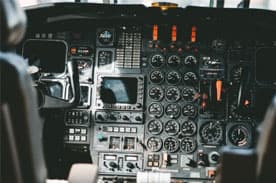
You are excited for your career to take flight, but you haven’t even made it onto the runway. The aircraft maintenance field in Canada is constantly booming with opportunities, like the recent $2.1M funding to service Sea King helicopters. Additionally, MTU Maintenance Canada recently celebrated their 20th anniversary in business, showing that this industry is here to stay. If the excitement you get from big news like this can’t be ignored, get yourself on the launch pad and learn the skills and training you need to begin your career.
Understand what job responsibilities you are interested in performing. Aircraft maintenance technicians maintain, troubleshoot, and repair aircraft. There are also Aircraft Maintenance Engineers (AMEs) who perform the same type of tasks as technicians. They also enjoy privileges that permit them to approve work done on an aircraft or aeronautical product, and to sign maintenance releases so that an aircraft or aeronautical product can return to service.
To start on your career path, find out what licence you need for what exactly you want to do. There are three different types of AME licences that correspond to the job functions you would be interested in performing.
- M ratings for airframes and power plants
- E rating for avionics
- S rating for structures
Get the training and experience you need. In order to become an Aircraft Maintenance Engineer, you need to have at least four years of aircraft maintenance experience. You will also need to successfully complete a Transport Canada approved or accepted training program (like the ICS Canada program), and you need to pass the Transport Canada AME licence examinations.
Get yourself into the right training program. Transport Canada reviews training programs to ensure that they meet curriculum requirements for the AME licence. The ICS Canada Aircraft Mechanics program is an accepted basic training program for the AME licence, “M” rating. This program includes practical labs and workshops that provide graduates with experience credit of up to 18 months towards qualifying to work on airframes and power plants. Accepted programs, like the ICS Canada Aircraft Mechanics program, have the required basic training curriculum to become an AME, but do not provide graduate with experience credits, so our graduates have to work at least 4 years in aircraft maintenance before they can qualify to write the licencing exams.
After you get the training you need, you’ll need to start working to get the required maintenance experience. Aircraft maintenance experience is accumulated on the job performing maintenance tasks. Transport Canada has a list of maintenance task types. When a listed maintenance task is successfully accomplished and the work is approved by a licenced AME, the AME can then sign the technician’s logbook. The experience requirements for the licence can be met with at least four years of maintenance experience and a sufficient number of diverse tasks completed.
The final step is to take your exams. An AME applicant who meets the experience and training requirements can schedule to write the Transport Canada AME licencing examinations. There are four exams: standard practices, airframes, powerplants, and regulations. The curriculum of approved and accepted training, like the ICS Canada Aircraft Mechanics program, will prepare an applicant to write the M rating exam.
There is a lot involved to break into this challenging, yet rewarding field, but you can do it and ICS is here to help. Contact an admissions specialist at 1-888-427-2400 to find out how to make this flexible and affordable program fit into your life and help you on your path to your dream career.